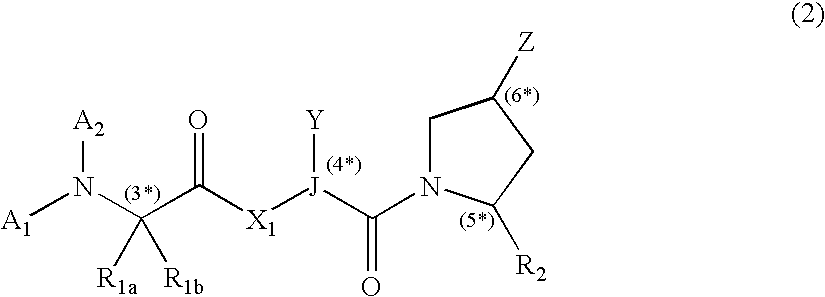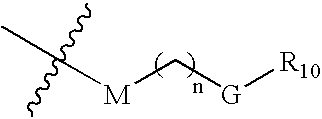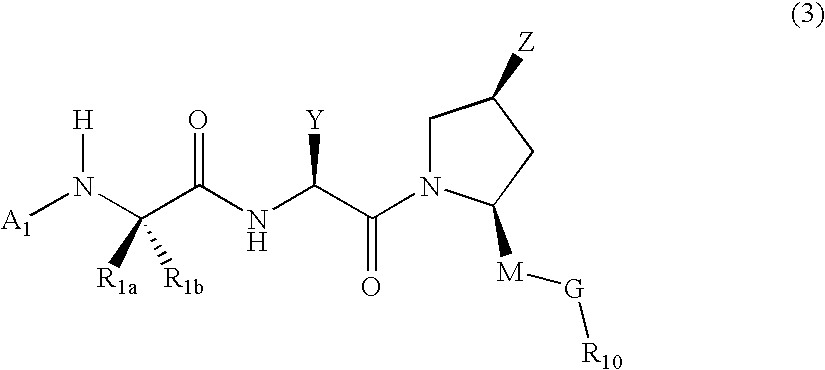IAP binding compounds
a technology of binding compounds and peptides, applied in the field of iap binding compounds, can solve the problems of short half-life of therapies, potential immunogenic reactions, lack of molecular specificity of therapies, etc., and achieve the effect of reducing or eliminating cellular proliferation disorders
- Summary
- Abstract
- Description
- Claims
- Application Information
AI Technical Summary
Benefits of technology
Problems solved by technology
Method used
Image
Examples
example 1
[0152] Binding constants (Kd) were measured using fluorescence polarization as described by Zaneta Nikolovska-Coleska, Renxiao Wang, Xueliang Fang, Hongguang Pan, York Tomita, Peng Li, Peter P. Roller, Krzysztof Krajewski, Naoyuki Saito, Jeanne Stuckey and Shaomeng Wang, in “Development and Optimization of a Binding Assay for the XIAP BIR3 Domain Using Fluorescence Polarization”, Analytical Biochemistry 2004, 332, 261-273). Briefly, test IAP binding compounds at various concentrations for binding measurements were mixed with 5 nM fluorescently labeled peptide (AbuRPF-K(5-Fam)-NH2) and 40 nM of XIAP-BIR3 for 15 minutes at room temperature in 100 μL of 0.1M Potassium Phosphate buffer, pH 7.5 containing 100 μg / ml bovine γ-globulin. Following incubation, the polarization values (mP) were measured on a Victor2V using a 485 nm excitation filter and a 520 nm emission filter. IC50 values were determined from the plot using nonlinear least-squares analysis using GraphPad Prism. The Kd values...
example 2
[0153] This example illustrates use of compounds of embodiments of the present invention that can be used in a method of treating cells. The method using these IAP binding compounds can include administering to abnormal cells, which may be known to overexpress IAP as well as other cell lines related to developmental disorders, cancer, autoimmune diseases, as well as neuro-degenerative disorders such as but not limited to for example SK-OV-3 cells, HeLa cells or other cells, an amount of the IAP binding compounds or IAP binding cargo molecules in various embodiments of formula (2), (3), or (5) that is effective to reduce, eliminate, or otherwise treat the sample of cells.
[0154] The MTT assay is an example of an assay that has been used for measuring cell growth as previously described (Hansen, M. B., Nielsen, S. E., and Berg, K. J. Immunol. Methods 1989, 119, 203-210) and incorporated herein by reference in its entirety. Briefly, SK-OV-3 cells were seeded in 96-well plates in McCoy'...
example 3
[0157] This example illustrates the preparation of pyrrolidine derivatives of Table 2. The examples include molecules of formula (E3) that can include heteroalkynyl substituents.
[0158] The Preparation of 2S-Amino-N-[2-methyl-1S-(4S-phenoxy-2S-phenoxymethyl-pyrrolidine-1-carbonyl)-propyl]-propionamide hydrochloride (7):
[0159] A. (4S)-Phenoxy-(2S)-phenoxymethyl-pyrrolidine-1-carboxylic acid tert-butyl ester (2):
[0160] To a solution of alcohol 1 (0.53 g, 1.8 mmol) in anhydrous DCM (10 mL) was added phenol (0.21 g, 2.3 mmol), Ph3P (0.52 g, 2.0 mmol), and 1,1′-(azodicarbonyl)-dipiperidine (ADDP, 0.50 g, 1.9 mmol) in sequential order. After 2 hr at ambient temperature, the heterogeneous reaction mixture was filtered. The white solid was washed with DCM and the clarified filtrate was washed with 2M NaOH, water, brine, dried with anhydrous Na2SO4, filtered and concentrated. The crude aryl ether was purified by flash silica gel chromatography (3:1 hexane / EtOAc) to afford 0.36 g (54%) of ...
PUM
| Property | Measurement | Unit |
|---|---|---|
| Molar density | aaaaa | aaaaa |
| Molar density | aaaaa | aaaaa |
| Electrical conductance | aaaaa | aaaaa |
Abstract
Description
Claims
Application Information
 Login to View More
Login to View More - R&D
- Intellectual Property
- Life Sciences
- Materials
- Tech Scout
- Unparalleled Data Quality
- Higher Quality Content
- 60% Fewer Hallucinations
Browse by: Latest US Patents, China's latest patents, Technical Efficacy Thesaurus, Application Domain, Technology Topic, Popular Technical Reports.
© 2025 PatSnap. All rights reserved.Legal|Privacy policy|Modern Slavery Act Transparency Statement|Sitemap|About US| Contact US: help@patsnap.com



